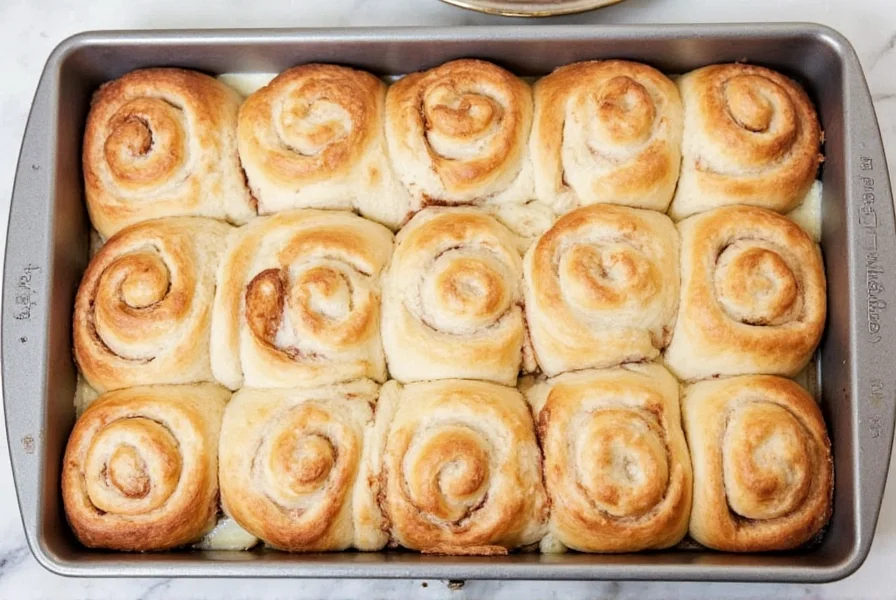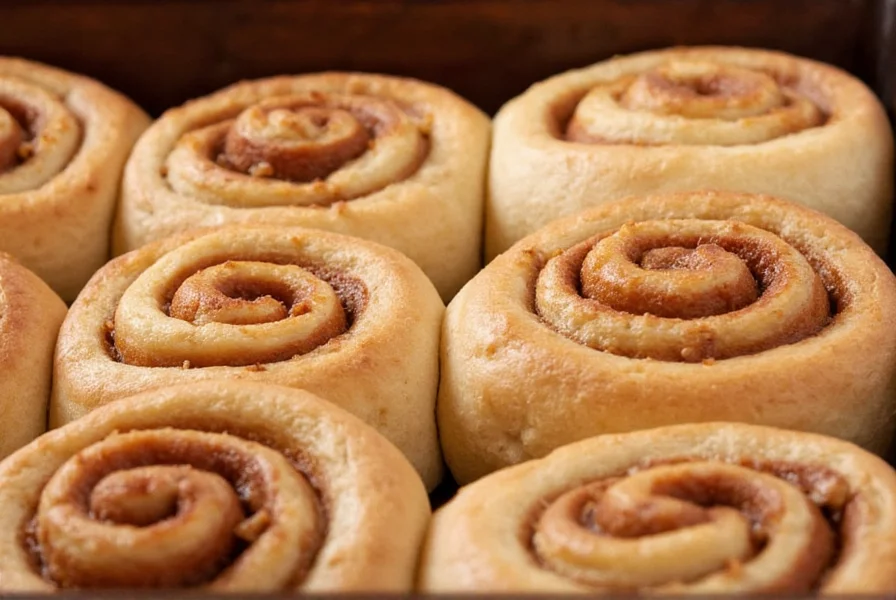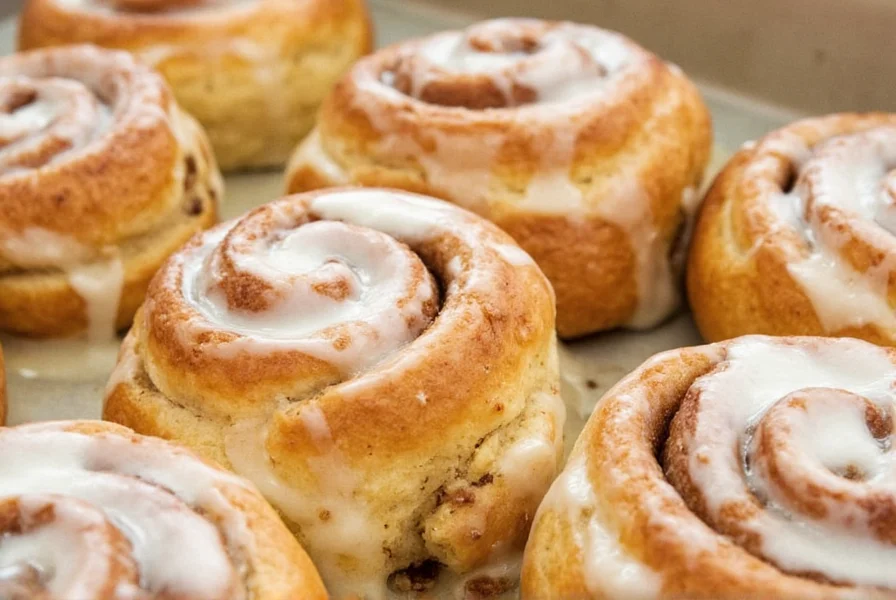Mastering the art of cinnamon roll baking transforms a simple breakfast treat into an aromatic, melt-in-your-mouth delight. This comprehensive guide reveals professional techniques for consistently perfect results, whether you're a beginner or refining your skills. We'll explore the science behind dough development, optimal baking conditions, and troubleshooting common issues that plague home bakers.
Essential Ingredients for Exceptional Cinnamon Rolls
The foundation of outstanding cinnamon rolls begins with quality ingredients measured precisely. Unlike many recipes that use all-purpose flour, professional bakers prefer bread flour for its higher protein content (12-13%), which creates the ideal gluten structure for pillowy soft rolls that hold their shape.
| Ingredient | Standard Measurement | Professional Tip |
|---|---|---|
| Bread flour | 3½ cups (440g) | Spoon and level method prevents over-measuring |
| Unsalted butter | ¾ cup (170g), room temperature | European-style (82% fat) creates richer flavor |
| Active dry yeast | 2¼ tsp (7g) | Test viability in warm liquid before use |
| Dark brown sugar | ¾ cup (150g) for filling | Higher molasses content creates complex flavor |
Step-by-Step Baking Process
Successful cinnamon roll bake from scratch requires attention to critical timing and temperature checkpoints. Follow these professional steps for bakery-quality results:
Dough Preparation (45 minutes)
Dissolve yeast in warm milk (105-110°F) with 1 tbsp sugar. Wait 5-10 minutes until foamy. Combine with melted butter, eggs, remaining sugar, and salt. Gradually incorporate bread flour until a soft dough forms. Knead 8-10 minutes until smooth and elastic. The best cinnamon roll bake recipe avoids adding excess flour during kneading, which causes tough rolls.
First Proofing (1-2 hours)
Place dough in greased bowl, cover with damp cloth. Proof at 75-80°F until doubled. Cooler temperatures extend proofing time but develop better flavor. Never rush this stage - under-proofed dough won't rise properly during cinnamon roll bake time.
Rolling and Filling Technique
Roll dough into 18x12 inch rectangle. Spread softened butter evenly, then sprinkle cinnamon-sugar mixture (1 cup dark brown sugar + 3 tbsp cinnamon). Roll tightly from long edge, pinch seam. Use unflavored dental floss to slice rolls cleanly without squishing.

Optimal Baking Conditions
The critical phase of your cinnamon roll bake requires precise temperature control. Preheat oven to 350°F (175°C) with rack in center position. Bake proofed rolls 20-25 minutes until internal temperature reaches 190°F. Rotate pan halfway through for even browning. Overbaking by just 3-5 minutes dries out the delicate crumb.
For the soft cinnamon roll bake technique that stays fresh longer, remove rolls from oven when centers still appear slightly underdone. Residual heat continues cooking during cooling. Test for doneness by gently pressing center - it should spring back slowly.
Troubleshooting Common Issues
Even experienced bakers encounter challenges with cinnamon roll bake troubleshooting. Here's how to solve frequent problems:
- Flat rolls: Over-proofed dough or excessive sugar in filling causing collapse. Reduce proofing time by 20% and use moderate filling amounts.
- Dry texture: Overbaking or too much flour. Use oven thermometer for accuracy and measure flour by weight.
- Dense crumb: Under-proofed dough or killed yeast from hot liquid. Verify yeast viability and maintain proper liquid temperatures.
- Burning bottoms: Oven rack too low. Place pan on upper rack with baking sheet below to catch drips.
Advanced Techniques for Perfect Results
Elevate your how to bake perfect cinnamon rolls with these professional secrets:
- Overnight method: Refrigerate shaped rolls for 8-12 hours. Cold fermentation develops complex flavors while making morning baking effortless.
- Steam injection: Place oven-safe dish with water on bottom rack during first 10 minutes of baking for professional-level oven spring.
- Temperature monitoring: Use instant-read thermometer to verify internal temperature reaches 190°F for optimal texture.
- Glaze timing: Apply warm icing immediately after baking for perfect absorption without sogginess.

Variations and Customizations
Once you've mastered the cinnamon roll baking temperature fundamentals, experiment with these popular variations:
- Apple cinnamon rolls: Add 1 cup finely diced apples to filling
- Cheesecake swirl: Incorporate 8oz softened cream cheese into dough
- Maple pecan: Replace sugar with maple sugar and add toasted pecans
- Spiced chai: Infuse milk with chai spices during preparation
Storage and Reheating Guidelines
Proper storage maintains freshness of your cinnamon roll bake for up to 5 days. Cool completely before storing in airtight container with parchment between layers. For longer storage, freeze unbaked rolls on parchment-lined baking sheet, then transfer to freezer bags.
Reheat frozen rolls by placing directly in 325°F oven for 25-30 minutes. Fresh rolls revive best when wrapped in damp paper towel and microwaved 10-15 seconds. Never reheat at high temperatures which cause rapid moisture loss.
Conclusion: Mastering Your Cinnamon Roll Bake
Perfecting the cinnamon roll bake time and technique requires understanding the balance between science and art. Temperature control, proper proofing, and careful ingredient selection transform simple components into extraordinary pastries. Remember that environmental factors like kitchen humidity and altitude affect results, so adjust liquid amounts and proofing times accordingly. With these professional insights, you'll consistently produce bakery-quality cinnamon rolls that delight with their tender crumb and aromatic spice.
Frequently Asked Questions
Can I use instant yeast instead of active dry yeast for cinnamon rolls?
Yes, you can substitute instant yeast 1:1 for active dry yeast. The primary difference is instant yeast can be mixed directly with dry ingredients without proofing in liquid. When using instant yeast, reduce sugar in the liquid by 1 tsp as it doesn't require the same activation process. Many professional bakers prefer instant yeast for more consistent results in cinnamon roll baking.
Why do my cinnamon rolls collapse after baking?
Collapse typically occurs from over-proofing (dough rises too much before baking) or excessive sugar in the filling which liquefies during baking. To prevent this, reduce proofing time by 20-30 minutes and use moderate filling amounts. Ensure your oven has fully preheated to 350°F before baking, as a low oven temperature causes slow rise and structural failure.
How can I make my cinnamon rolls stay soft longer?
For extended softness, incorporate 2 tbsp of potato flour or instant mashed potato flakes into your dry ingredients. These ingredients retain moisture better than standard flour. Additionally, brush warm rolls with melted butter immediately after baking, which creates a moisture barrier. Proper storage in an airtight container with parchment between layers prevents drying.
What's the ideal internal temperature for perfectly baked cinnamon rolls?
The ideal internal temperature for perfectly baked cinnamon rolls is 190°F (88°C) measured at the center with an instant-read thermometer. At this temperature, the starches have properly gelatinized while retaining optimal moisture. Baking beyond 195°F causes excessive moisture loss, resulting in dry rolls. Remove rolls from the oven when centers reach 185°F as residual heat will continue cooking them.
Can I bake cinnamon rolls in a convection oven?
Yes, but reduce temperature by 25°F and check for doneness 5 minutes early. Convection ovens circulate hot air, which can cause faster browning and potentially dry rolls if not adjusted. For best results with cinnamon roll bake in convection mode, place rolls in the center of the oven and rotate the pan halfway through baking. Monitor closely during the final minutes as convection baking can finish 10-15% faster than conventional ovens.











 浙公网安备
33010002000092号
浙公网安备
33010002000092号 浙B2-20120091-4
浙B2-20120091-4